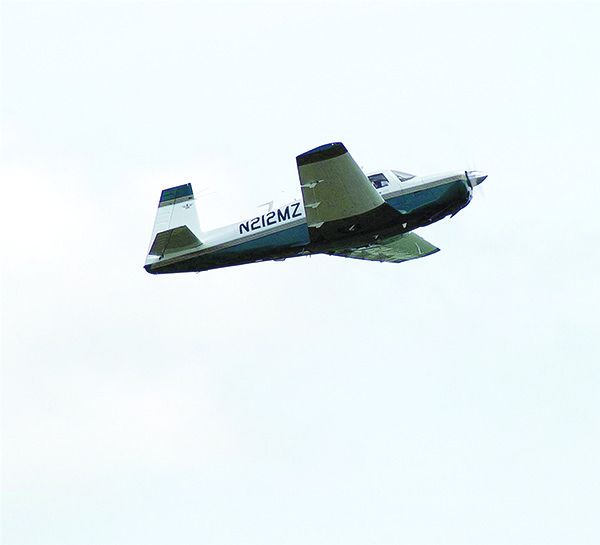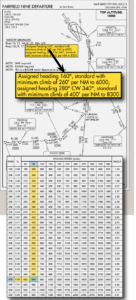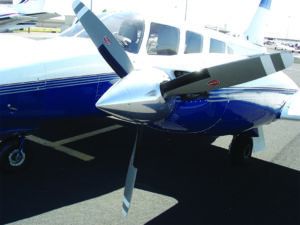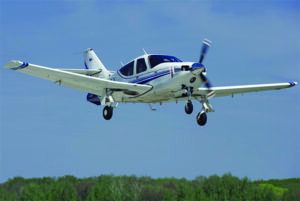
It was a moonless night in the valley, with a strong wind behind us from the north. I usually fly single-pilot, but that night I had a new hire, an old friend, with me. He was getting to know a new-to-him airplane. We talked about the terrain and the wind and the runway length, and that I had been to the destination airport recently. It was a good briefing. We decided to enter on the downwind for a visual approach.
On base leg, the runway was in sight. I was really surprised to hear an automated female voice saying “Terrain! Pull up!” But I could see the runway, so I hesitated. “You’d better climb,” my friend said, very calmly, and I realized he meant it, so I added a lot of power and pulled the nose up just short of stalling, just like I’d practiced in the simulator. They call it an escape maneuver. Now that was a climb.
FOUR FORCES
Of course, climbing is something we do every flight. What’s happening to the airplane while it is climbing? And how can we climb better?
The four forces acting on an aircraft in flight taught in ground school explain what’s happening in a steady-state climb. The airplane is not accelerating, so there is no net force. Lift, drag, thrust and weight must “add up” to zero. In level flight, thrust and drag generally have to have the same magnitude, as do weight and lift. Climbing changes the relationship, however.
The four forces don’t explain what happens during the escape maneuver. Adding power changes the thrust. Raising the nose changes the airspeed. There is no steady-state. What climb affects is energy, what I’ve called essence (see “The Essence Of Flight,” July 2021). Essence includes velocity, which determines what physicists call kinetic energy, and altitude, which determines what physicists call potential energy. Essence also includes the chemical energy in the fuel tanks, as well as the psychological energy of my friend’s calm admonition.
Energy can’t disappear; physicists call that conservation of energy, which can be converted from one form to another, usually bumping into some inefficiencies along the way. A zoom climb—a chandelle without the turn—converts airspeed into altitude. Adding power converts chemical energy into thrust, which increases kinetic or potential energy, as the pilot chooses. To perform that kind of escape maneuver, choose potential energy.
CHOICES
There is more than one way to climb. Start on the ground with an obstacle at the far end of the runway. Getting over the obstacle means you need a steeper angle, and as private pilot students we learned to do a short-field takeoff.
As I relate in the sidebar on page 19, that’s one of the most dangerous maneuvers in the private pilot curriculum. It’s done near the ground. At high power and low airspeed, there is lots of P-factor, so if the student increases the angle of attack too much and stalls, the resulting spin will be fatal, quickly.
You learn how in one airplane, and as you go on to fly other types, the short-field takeoff should be part of the checkout. Follow the POH, and remember that more power means more P-factor.

Some standard departure procedures (DPs) and obstacle departure procedures (ODPs) specify a minimum climb gradient. For example, on some headings the Fairfield Nine departure from Salt Lake City International demands a climb gradient of 400 feet per nm. There is a gradient-to-rate table buried somewhere in the instrument procedures, but it can be hard to find. (It’s on the inside back cover of the printed version of the FAA’s terminal procedures booklets. In ForeFlight, and perhaps other EFB apps, it’s in the Digital Terminal Procedures Supplement. — Ed.) You need a high climb rate on the Fairfield Nine. What climb rate do you need? Yes, some math is required.
The climb rate depends on groundspeed—at 0 knots groundspeed, you can climb slowly and clear everything. Groundspeed depends on true airspeed (TAS). At a high-elevation airport like KSLC, the TAS is higher, in this case about nine percent higher, so climbing at an indicated airspeed of 90 knots means TAS is almost 100 knots. Leaving Colorado Springs, with an elevation above 6000 feet msl, means that TAS is about 12 percent higher, so 90 KIAS is nearly 101 KTAS. Sounds simple, right? Then you need to factor in the wind.
To get a rough idea of what you need, remember that one nautical mile is about 6000 feet. That means a climb of 400 feet/nm is a ratio of about 1/15. Your vertical speed for this climb needs to be 1/15th of the groundspeed. So if groundspeed is 90 knots, the required vertical speed is 90/15 = 6 knots, which is 600 fpm. If fractions aren’t your thing, use the FAA’s climb/descent rate table, as shown at right.
AWAY FROM THE GROUND
Once away from the ground, the pilot has more climb choices. Usually power is set to the maximum allowed. The POHs call this by different names: maximum continuous power, climb power and the like. You don’t get to choose. But you can choose the airspeed. Each airspeed has advantages and disadvantages.
The four forces explain what’s going on here. Pick an airspeed and set the airplane up for level flight. Power determines thrust, which is opposed to drag, which, in turn, depends on airspeed. There is a power setting that balances all of these factors. For example, a Cessna 172 at 5000 feet msl on a standard day, at 1900 rpm, flies level at about 80 KIAS.
Now add power. The four forces aren’t in equilibrium anymore. Adding power converts the chemical energy in your fuel tanks into dynamic energy. The airplane either has to speed up or climb.
Increased thrust means increased energy. If the speed is constant, there is no change in kinetic energy. The only possible change is in potential energy, that is, altitude. If, instead, the height is constant, there is no change in potential energy. The only possible change is in kinetic energy, that is, airspeed. An airplane climbs because of extra power, at least in still air. (A glider has no power, so it only climbs when the air is rising.)
All things being equal, a light airplane needs a little less power to achieve a given climb rate, and a heavy one needs a little more power. This is most noticeable in airplanes that have a really big useful load. The Pilot’s Operating Handbook for an airplane like this usually has performance data for different weights. This has an important practical consequence. A heavier airplane needs more power to stay level, so there is less extra power available, so the climb rate is lower.
Choosing climb airspeed depends on a lot of factors. Turbine engines perform better at altitude, so climbing at or near the best rate, or VY, is usually most efficient, but can also be uncomfortable, so a little efficiency is sacrificed. The POHs or AFMs for turbine-powered airplanes usually include a climb schedule, which takes into account the change in true airspeed as the airplane climbs. Turbine-powered airplanes should be flown by the book.
The pilot of a piston-powered airplane has more flexibility. For example, departing to the west on a trip to the east probably requires climbing to pattern altitude, or above, before it is safe to turn on course. In that case something close to a VY climb works, because you need the higher climb rate. Once clear of terrain and pointed in the right direction, though, it seems better to increase the airspeed so you can make more progress down the road. I consider 500 fpm to be a nice climb rate if the airplane can do it, but that may not be possible in a Cessna 150 on a hot day.

Multi-engine airplanes have more power and climb at a higher rate. Right up until an engine fails.
Take a 4000-pound airplane at 100 KTAS with 400 horsepower available; this is about right for a Piper Seneca II. It takes about 120 horsepower to fly the Seneca level at that weight. When both engines are running, there are about 280 excess horses of thrust available, for a whopping rate of climb. But on one engine, the excess thrust available is now about 80 horsepower, and the rate of climb is cut down proportionally (80/280 in this case). With a windmilling propeller, the drag picture is a lot worse, too, so the lift-to-drag ratio (L/D) has gone down and there is even less excess thrust. The point is that losing half the power costs you much more than half the climb rate.
An engine failure in a twin airplane causes control problems as well, thanks to asymmetrical thrust and asymmetrical drag. That’s why a twin requires more training and practice
GEORGE
Most autopilots have several climb modes, usually pitch, speed and/or rate. In pitch mode, the autopilot holds the nose at a set location above the horizon. The others hold airspeed or vertical speed constant, adjusting the pitch as needed.
I don’t climb in constant-rate mode. As you climb, power starts to drop off, and the autopilot will pitch the nose higher and higher to keep climbing at the same rate. (In a turbocharged airplane, the power can stay constant for a while, but eventually you reach the engine’s critical altitude and it starts to fall off.). If this goes too far, the airplane stalls, the autopilot disconnects and the human pilot has to regain control of a grossly out of trim airplane that may even be spinning.
In constant-speed mode, the autopilot pitches the nose down as the higher altitude results in less power being available (normally aspirated engine), which is much more manageable.
One way to use raw pitch mode is for en route climb. Suppose you are cruising at 140 KIAS and you need a climb. Change to pitch mode and raise the nose to a climb attitude, which will cause airspeed to decrease, among other behaviors. When the airspeed slows to your desired climb speed, put the autopilot into speed mode. (Add power while you are at it.)
TEMPS AND PRESSURES
Two kinds of pressure affect the craft while climbing, one outside, one inside. Outside, the air pressure decreases as the altitude increases. One way to think of air pressure is as the weight of the column of air above the airplane. If the airplane is higher, the column is shorter, so there is less weight and hence less pressure.
Air density is decreasing, too, so the stall speed is increasing. This is harder to see. Lift depends directly on density, so an airplane flying in less dense air needs more airspeed to stay level. Luckily, the relationship between true and indicated airspeed also depends on density, in exactly the same way, so while the true stall speed is increasing, the indicated stall speed stays the same.
Inside, the thinner air means less oxygen for you and your passengers. You can breathe supplemental oxygen, or you can pressurize the cabin. Full details would require another article, but here’s one that is often overlooked: Make sure everything works before you climb high. Be sure that the oxygen bottle is in reach, full and turned on, and that you have the right masks and hoses available, and in reach. If the airplane is pressurized, make sure the pressurization system is activated and check that the cabin is being pressurized during the climb.
THE END OF THE CLIMB
Pilots love to climb, but no airplane can climb forever. The transition from climbing flight to level flight is far from a steady state situation, so the four forces don’t explain what is going on. The airplane starts in a steady state, using maximum allowable power at, say, 70 KIAS, and ends in a different steady state, using cruise power at, say, 110 KIAS. Put differently, the maneuver starts with increasing potential energy and ends with increasing kinetic energy. That’s the key to understanding the transition: in both cases the dynamic energy increases. The only way to do that is to burn fuel.
In practice, the most efficient way to transition from a climb to level flight is to lower the nose to the cruise attitude and leave the power alone. The goal is to increase kinetic energy, and that takes power. Reduce drag as much as possible, and keep trimming until the airplane is at cruise speed. Only then reduce power to your preferred cruise setting.
The alternative, which too many pilots choose, is to reach altitude and immediately reduce to cruise power. This works; after a while, the airplane slo-o-o-o-owly accelerates to cruise speed. If you set cruise power while flying at a slower airspeed, the four forces are not in equilibrium, and in level flight, the airplane will accelerate. But it accelerates faster if you use more power.
Leveling off can be confusing at higher altitudes, where cruise indicated airspeed is low. A King Air 200 climbs comfortably at 150 KIAS (this is a little faster than the book speed, but is more comfortable for passengers). At altitude, cruise speed is generally around 175 KIAS. That’s a small change, less than 15 percent. But in a Cessna 172, the indicated airspeed might be 70 in the climb and 95 in cruise, which is a greater relative change.

A few years ago, a designated pilot examiner and a private pilot candidate were killed when the airplane stalled and spun. The problem is the high angle of attack—during a short field takeoff the angle of attack increases toward the stall angle. The combination of low airspeed and high power produces lots of P-factor, usually a left-turning tendency. That’s yaw. A stall with yaw is a spin.
As an instructor doing checkouts, I never start with a short-field takeoff; an ordinary takeoff can be thrilling enough with a rusty or transitioning pilot. When we do finally try the short-field takeoff, I keep my hand behind the yoke or stick, ready to push forward if necessary. I’ve had to do it a few times.
SMALL CLIMBS
Once en route and trimmed for cruise, there are other things for a pilot to focus on. But turbulence or distraction can cause the airplane to lose a little altitude. What should you do when you are 200 feet below your desired altitude?
That’s actually a difficult question. One answer is to add power, which makes the airplane climb. But power changes waste fuel, and thus essence. When you add power, the fuel system sends more fuel to the engine, but until the engine accelerates that’s too much fuel. That’s why the Boeing 777 was designed to correct small altitude deviations with pitch alone.
But pitching up causes its own difficulties. Pitching up makes the airplane slow down, and now the pilot has the same problem leveling off as before, waiting while the airplane slowly reaccelerates to cruise speed. For a short climb, this is probably acceptable.
FINAL WORD: ESCAPE MOVES
Pilots love to climb. And sometimes pilots have to climb. A clean airplane at maximum power climbs well at the correct airspeed. But cleaning up can cause other aerodynamic problems, as flaps and gear try to move against the airflow, so it’s usually better to climb in the configuration you’re in.
Jim Wolper is an airline transport pilot and mathematics professor. He’s also a CFI with single-engine, multi-engine, instrument and glider ratings.



